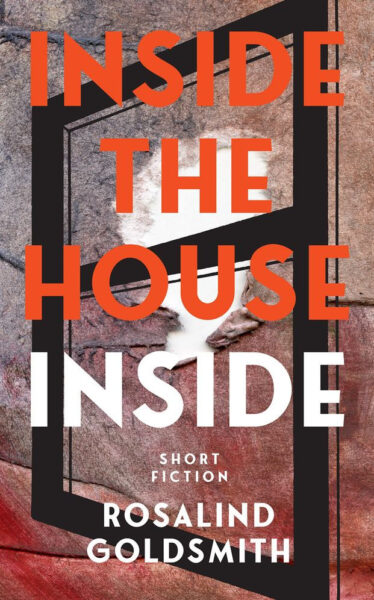
Reviewed by Emily Webber
The flash fiction stories in Rosalind Goldsmith’s debut collection Inside the House Inside (Ronsdale Press, May 2025) contain a frantic energy with characters spewing their angst and fear across the page at a quick-fire pace. A homeless woman in “Getting by on York Street” complains about the passing of days: “Why does she — why does it — bother? What’s left now to hold on to? Clear enough: nothing. But it’s a stupid, blind-eyed brute, the will to survive — and hard to wrestle it down.” These characters are on the edges of society, slipping into invisibility as they battle hardship, wondering how to survive another day.
Some of the things characters lose in this book are: hair, teeth, identity, a drawer from a dresser, a house, an apartment, loved ones, health, a bag of chips and soda, bones, innocence, sanity, control, and sleep. Found in the spaces left are a spark of old memories, indifference, loneliness, survival, invisibility, and hard truths. An experience of loss is best described in the surreal story “That Old Life,” where a woman is chased by her own life, still trying to go about her routines when she meets an old man at a diner.
This world is here to knock the bones out of us — every one of us — piece by piece and splinter by splinter and agony by agony, until we are just a lump of heaving, shivering jelly. And that’s it. That’s the whole thing. And the world — the world I say — the world will go on knocking it out of us until we get it. Yes it will. And if we don’t get it now, we will get it later.
There’s a danger the reader may start to disassociate from these characters in the onslaught of doom and gloom, but Goldsmith interjects reminders of humanity. A character in “Icicles” on the verge of a breakdown says: “I lived in a real house once. It had bricks and a roof. And windows. And a mother in it.” A boy runs from a group home, where he’s been placed after his father died, and remembers the ocean.
He dunked his head in once, long ago. At the beach with his sister and his parents. He ran out into the shallows, head-butted into the waves of the sea, embraced them and went right under. In that plunge, he felt the whale silence of underwater depths and it was love to him, all peace and grave green quiet. In the fretful years after, this was the feeling he’d tried to recover and never could.
Goldsmith, who has written radio plays, has fabulous descriptions. Dead hummingbirds are described as “strewn across our wide-yards like dropped commas.” A group home is “a dark, maggoty place, a black hive that would mildew the heart.” The face of the manager at the grocery is “bloaty, blotchy, and slack, like he just got out of the toilet after throwing up an all-night binge. He’s bald and there’s a dent in his forehead — hoof-shaped, like the devil kicked him.”
These descriptions create a vivid world, and Goldsmith also uses form to heighten the agitated and distressed state of the characters. Many stories are delivered in monologue, stream-of-consciousness style, as if the characters are pleading with the reader to understand their pain. A woman comes home to her apartment in “Renter” to find her landlords and others occupying her space. The text is indented and outdented like her confused wandering from room to room. In “come back & no don’t” the words are mashed together as the character’s rant grows more bizarre.
A few of the most haunting stories in the collection focus on the aftermath of childhood trauma. A girl grows up in a home with a sick mother and abusive father in the titular story “Inside the House Inside.” She manages to escape with a child of her own, but finds herself yelling at her daughter using the same derogatory name as her dad called her. She may have physically left behind the abuse, but not mentally.
And down the years, first scant then fleet, she’ll carry all of this with her: sick mother, raging father, and the old wooden house structured up inside her. She’ll never get rid of it — every event, every moment of her life will step and shift inside the walls of that house, built up rotten board by rotten board by rotten board within her.
The trauma also lingers in “Stillchild,” Goldsmith’s take on a missing girl story. The adults all watch the girl in the aftermath and marvel at their luck, how the kidnapped girl seems the same after being abducted by a man and found alive hours later in the woods. Goldsmith details an evocative image of what the girl carries within herself.
Inside, she carries the child she was when she died. The dead child. The murdered child that lay in a ditch, her golden hair transgressed with mud, her face turned sideways to the earth, leaves raked loosely over her body. And as the girl grows, the dead child stays with her, sits on her pillow at night and whispers stories, teaches her the ways of people, scrawls weird words on the walls of her room, guides her, all smiling, through the dark warp of dreams
In the opening story of the collection “Forsythia,” a couple is evicted from their home, their belongings packed into an RV, looking for somewhere else to land. They only find a burned-out cabin and vow to stay and fix it, claiming it as their own. It can seem like a new beginning, but Goldsmith reminds us that they have nothing, ending the story with an image of them looking for shade: “None though, that they could see.” Goldsmith’s stories in Inside the House Inside show what life knocks out of people and how they hang on.
You can pre-order Inside the House Inside through your local bookseller, forthcoming on May 5, 2025.
__________________________
 Emily Webber is a reader of all the things hiding out in South Florida with her husband and son. A writer of criticism, fiction, and nonfiction, her work has appeared in the Ploughshares Blog, The Writer, Five Points, The Rumpus, Necessary Fiction, and elsewhere. She’s the author of a chapbook of flash fiction, Macerated. Read more at emilyannwebber.com
Emily Webber is a reader of all the things hiding out in South Florida with her husband and son. A writer of criticism, fiction, and nonfiction, her work has appeared in the Ploughshares Blog, The Writer, Five Points, The Rumpus, Necessary Fiction, and elsewhere. She’s the author of a chapbook of flash fiction, Macerated. Read more at emilyannwebber.com

 The core workshop of SmokeLong Fitness is all in writing, so you can take part from anywhere at anytime. We are excited about creating a supportive, consistent and structured environment for flash writers to work on their craft in a community. We are thrilled and proud to say that our workshop participants have won, placed, or been listed in every major flash competition. Community works.
The core workshop of SmokeLong Fitness is all in writing, so you can take part from anywhere at anytime. We are excited about creating a supportive, consistent and structured environment for flash writers to work on their craft in a community. We are thrilled and proud to say that our workshop participants have won, placed, or been listed in every major flash competition. Community works.